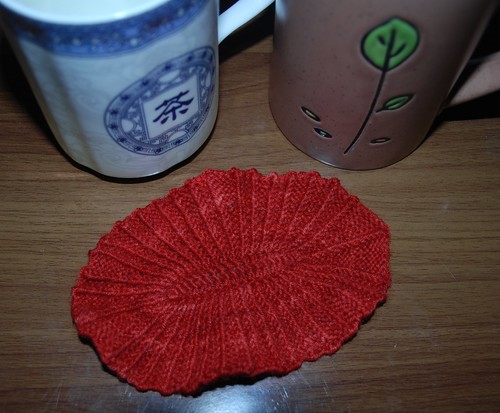I decided that something to put my tea mug on in the office was necessary, and of course wanted something fossily. Much though I like graptolites, they aren't the right shape for this - too much branching, not enough solidity. I didn't even consider doing a dinosaur. I decided to do something that was approximately 2-dimensional anyway, so chose my favourite Ediacaran. Meet Dickinsonia.
Yes, it really did look like this*. Flat, oval, with a central line and radiating rib-like structures. Bizarre, isn't it? Would you believe that this was a lichen? No, neither do I, but it has been suggested in the scientific literature. Other ideas for what it was include an annelid worm (i.e. an earthworm relative), a coral-like animal, or something completely extinct and not even an animal. The latest, and probably the best (i.e. most likely to be correct) idea is that Dickinsonia was a placozoan**. Living placozoans are so obscure that they don't have a common name, and they merited approximately 10 minutes of lecture in my undergraduate zoology course***. Living placozoans are like Dickinsonia in being flat and moving by creeping across a surface. However, living placozoans are much smaller than Dickinsonia - millimetre rather than centimetre size - and have an irregular outline and no consistent structure. Dickinsonia specimens always have roughly the same shape and form. However, if placozoans used to be much bigger, and the living ones we see have become small and simplified during evolution, this isn't an insurmountable problem.
The facts about Dickinsonia that we are sure of: it was alive and it lived approximately 550 million years ago. It lived together with a number of other living things, also of uncertain affinities. Collectively they're known as Ediacaran fossils, after the Ediacara hills of Australia, where they were first discovered. They've since been found all over the world, including Namibia, Siberia and Canada.
Apologies to those of you who were expecting a post about knitting!
* Wikipedia article with more pictures here: http://en.wikipedia.org/wiki/Dickinsonia
** Here is a link to the scientific paper, by Erik Sperling and Jakob Vinther: http://onlinelibrary.wiley.com/doi/10.1111/j.1525-142X.2010.00404.x/full
***A webpage about living placozoans here: http://www.ucmp.berkeley.edu/phyla/placozoa/placozoa.html and the wikipedia page here: http://en.wikipedia.org/wiki/Placozoa
Monday, 28 March 2011
Dickinsonia
Subscribe to:
Post Comments (Atom)


Bah! Humbug! That's not a Dickinsonia! It's a Dickinsonia wannabe!
ReplyDeleteDickinsonias ARE bilaterally symmetrical about a line along the mid line from top to bottom (both sides are bilaterally symmetrical), but are NOT bilaterally symmetrical along a line at 90 degrees to the central axis (the head and tail ends are not the same)